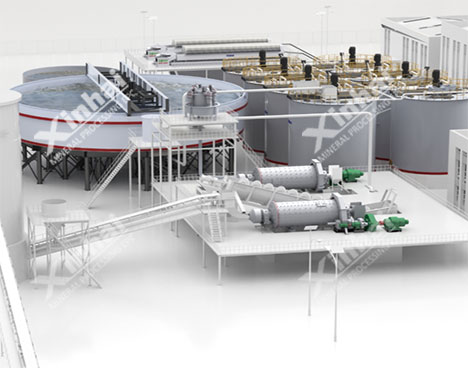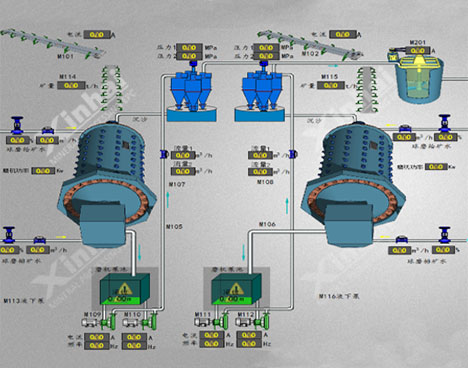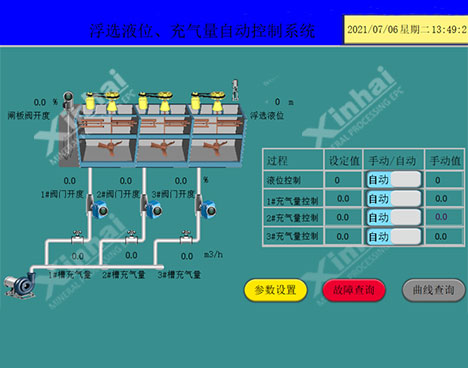Is your ore processing plant operating without personnel on-site? This is made possible by the full-process automation system for ore dressing!
The full-process automation control system for ore dressing is designed to achieve coordinated and optimized control of various stages in the ore dressing process, including crushing, grinding, screening, concentrate dewatering, tailings transportation, water systems, and more.

Implementing a full-process automation system in your ore processing plant can reduce labor costs, precisely control production outcomes at each stage, and enhance overall efficiency. It serves as a valuable assistant in cost reduction and efficiency improvement. Below, we will explore the advantages and implementation effects of various automated systems.
The automatic material bunkering system involves the automated dispensing of materials, ensuring even distribution and preventing accidents such as emptying or overloading of bunkers. It consists of bunkers, material level detection devices, belt conveyors, unloading trolleys, and unloading trolley positioning devices.
Advantages:
Supports various unloading vehicles, such as mobile unloading cars and plow-type unloaders.
Continuous and precise positioning of unloading trolleys with limit protection.
Utilizes radar level sensors with different ranges, beam angles, and strong dust resistance for real-time continuous measurement based on different bunker sizes.
Multiple material dispensing methods are programmatically designed to meet diverse needs, including automatic level-based material dispensing, interval-based bunker polling, and remote manual bunker designation.
Implementation Effects:
Replaces manual labor in harsh environments, achieving unmanned operation.
Remote operation reduces labor intensity and improves material dispensing efficiency.
Real-time monitoring of material bunker levels replaces manual observation, mitigating safety concerns.
Facilitates real-time control of material information for production scheduling, enhancing scheduling efficiency.
The crushing and screening automation system utilizes PLC control to detect the material level and power in the crushing chamber, optimizing control of ore feed quantity and adjusting the speed of the feeding machine to operate the crusher at near full load.

Advantages:
Full coverage of all key signals for all process equipment, ensuring real-time monitoring without blind spots.
Interlocking protection, equipment monitoring protection, timely warnings, and precise fault location.
Pre-alarm before start-up, with the system automatically determining whether start-up conditions are met, ensuring safe operation.
Multiple operation modes: local/remote manual/remote automatic, catering to various usage requirements.
Instrumentation, PLC selection, etc., meet dust environment usage requirements, ensuring stability and reliability.
Implementation Effects:
Achieves unmanned operation, primarily focusing on inspections.
Stabilizes the production process, balancing operational capabilities and efficiency.
Increases processing capacity per unit time for the grinding mill while maintaining grinding and classification indicators.
Provides various production reports and queries for optimized production scheduling.
The grinding and classification automation system utilizes automatic control to comprehensively analyze and judge factors such as the load of grinding equipment and the properties of ore feed, optimizing control of ore feed quantity, grinding concentration, classification overflow concentration, and particle size. The system also achieves automatic detection, display of parameters, and various fault alarms for grinding and classification operations, ensuring their optimal operation.

Advantages:
Automatic control of ball mill ore feed, automatic detection and switching of blockages at the discharge port.
Automatic adjustment of grinding concentration, overcoming water pressure fluctuations.
Automatic regulation of cyclone feed concentration, ensuring classification effectiveness.
Coordination of cyclone feed pressure and pump pit level for automatic adjustment.
Automatic addition of grinding balls using a ball-adding machine with real-time monitoring and fault pre-warning.
Integration of a "Grinding Audio Spectrum Analyzer" and "Online Particle Size Analyzer" for constructing a closed-loop optimization control system, improving grinding efficiency and product quality.
Implementation Effects:
Achieves unmanned operation, primarily focusing on inspections.
Stabilizes the production process, balancing operational capabilities and efficiency.
Increases processing capacity per unit time for the grinding mill while maintaining grinding and classification indicators.
Provides various production reports and queries for optimized production scheduling.
The flotation level control system includes level measurement devices, pneumatic or electric actuators, and intelligent controllers. Air volume adjustment includes an air flow meter and an electric regulating valve. Accurate real-time detection and control effectively enhance the flotation effect, playing a crucial role in the flotation process.

Advantages:
The designed level detection device effectively avoids the influence of flotation foam, accurately measuring slurry level height, and foam layer thickness.
No measurement problems or the need for continuous water spray devices.
Measurement range: 0~500mm; Accuracy: ±1.5% full range.
Improved PID control algorithm for faster and smoother control effects.
Each flotation cell is equipped with an operating touch screen for intuitive and quick adjustments.
The XHIMC intelligent control cloud platform includes functions such as production operation monitoring, work order task management, cost analysis reports, consumption material management, data entry, production statistics reports, personnel shift management, energy consumption statistics, intelligent inspection management, equipment maintenance strategies, and supply and sales weighing measurement.
The video surveillance and large-screen display system, as an auxiliary tool for automation systems and production scheduling management, plays a vital role in better utilizing centralized control and unmanned operations. It also provides better security for personnel, production equipment, and factory materials.
With its technological advantages, Xinhai Automation Company has accumulated a wealth of experience in automation and informatization for various ore types in the selection and production of iron ore, copper ore, molybdenum ore, gold ore, titanium zircon ore, lead-zinc ore, and heavy crystal ore, among others. The company provides customers with reasonable solutions for various production equipment and processes, including ball mill grinding and classification, semi-self-grinding processes, flotation, regrinding, electroselection, magnetic separation, thickening machines, and filter presses.